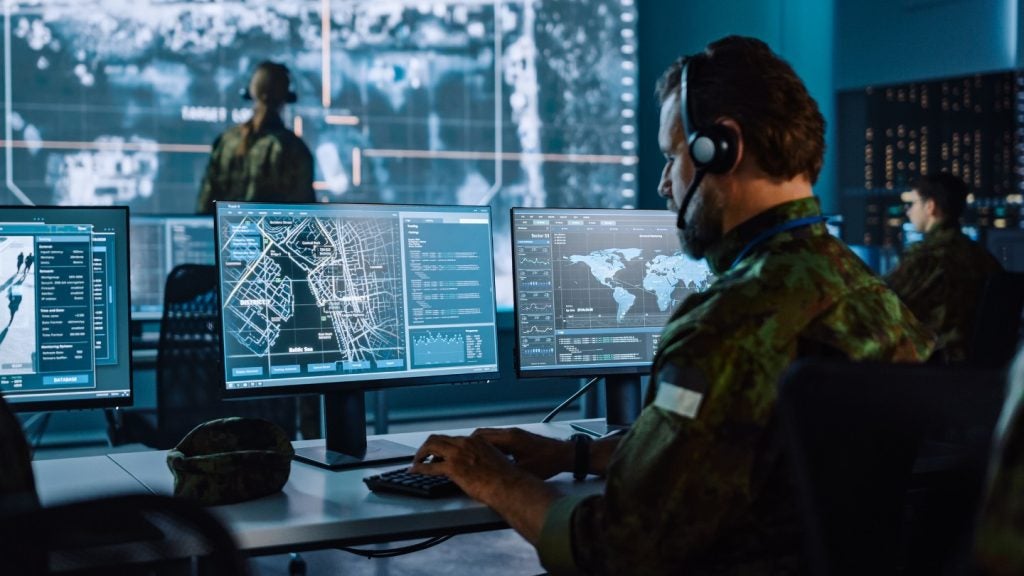The past year has seen a 16% rise in IoT professionals hired by the ADS industry, research by Avery Fairbank shows.
From the UK Ministry of Defence (MoD) and US Navy to Airbus and Boeing, the sector looks set to incorporate IoT technology in an international market expected to grow to $1.2trn by 2027, according to GlobalData’s Internet of Things in Defense report.
“Over the past few years defence organisations have grown much more comfortable with IoT devices communicating over public and private cellular”, says Neil Hendry, defence and government director at Digital Barriers and a former British Army officer.
Concerns about cybersecurity persist, but growth in the IoT military market has been spurred by drone use, communications systems and, increasingly, space satellite systems.
What applications does IoT have in aerospace and defence?
In defence and aerospace, the applications of these devices vary massively, from smart warehouses to fleet tracking, augmented reality (AR) training to use of drones to gain situational awareness.
IoT has also been implemented for health monitoring, according to Vance Tran, co-founder of Pointer Clicker and tech expert.
“Smart sensors can be used on military equipment to give data on their health and whether maintenance is needed,” says Tran. “This helps reduce operating costs and downtime for military equipment as the sensor can predict when a breakdown is imminent.”
Both IoT and the internet of battlefield things also use edge architecture to swiftly transmit data, making use of biometrics, environmental sensors and other connected devices.
Tran also points to military perimeter security as a key application.
“IoT can enhance access control and intrusion detection on bases, as well as securing critical infrastructure”, he says.
By using stolen credentials or posing as civilians, bad actors can gain entry to military sites. Active and passive IoT sensors can collect fingerprints, iris scans and other biometric data to identify authorised personnel.
How will ADS companies sidestep the IoT’s cybersecurity threat?
With cyberattacks on the rise across multiple industries and weaponised extensively during the Russia-Ukraine conflict, there is heightened focus on the risk posed by interconnecting military or secret service communications through IoT technology.
ADS companies must work hastily to construct strong cybersecurity systems to strengthen IoT-based military systems, according to Ron Stefanski, Business Professor at Cambridge College.
“The expansion of interconnected devices that come with IoT also widens the threat surface for potential cyberattacks, as my security-focused colleagues frequently remind me,” Stefanski says. “It is therefore imperative that ADS companies implement robust security safeguards to fortify their evolving technological ecosystems.”
Examples of communications hacking have been observed in ongoing conflicts.
Several Israeli agencies are reportedly using Pegasus to spy on Hamas’ mobile communications.
Pegasus, a ‘zero-click’ malware that can be placed onto a target’s comms device and activated without them knowing or needing to click any links, gives the attacker access to the target’s entire mobile device and data.
“Although we don’t know exactly what mobile communications technology Hamas prefers, they’re likeliest to be using WhatsApp or Signal, thinking their communications were secure,” says David Kay, CEO of Sotera Digital Security. “Pegasus works by exploiting vulnerabilities in the software – without a secure operating system, this type of spyware can infiltrate and mirror and target’s device.”

Pegasus use remains controversial. Recent reports suggest that Pegasus has been used to spy on Palestinian human rights activists as recently as 2021.
“Even if Hamas secured the apps they were using for communication, Pegasus would have breached the operating system and overridden any secure lines”, Kay adds. “Pegasus allows a hacker to see communications in real time before any encryption is applied by ‘secure’ messaging application.”
Tran reiterates that IoT’s connectivity increases risks around hacking and cybersecurity but holds a more optimistic outlook on the technology’s future in defence.
“IoT systems through cloud security, encryption, and access controls will be crucial, but, overall, IoT presents a big opportunity to leverage data and new tech like AI to gain advantages” he tells Army Technology. “With commercial aviation leading the way, defence players recognize the benefits of IoT for mission-critical systems and readiness. The market outlook is strong.”
IoT in aerospace – the next frontier?
While IoT adoption is increasing across the industry, certain companies are investing more heavily into the digitalisation space than others, according to Will Tyson, thematic analyst at GlobalData.
“Northrop Grumman uses IoT technology in its products and manufacturing processes,” Tyson says. “It is constructing a new missile integration facility, where smart equipment will be used to automate production and improve efficiency.”
This new factory was a decisive factor in the US Air Force awarding Northrop Grumman a $705m contract to deliver air-to-ground weapons in September 2023.
A month before, the UK Ministry of Defence (MoD) awarded BAE Systems with a $108m five-year contract to lead on building a deployable tactical wide area network (WAN) known as ‘Trinity’. This will enhance front-line connectivity for the military, linking small reconnaissance drones, combat vehicles, and military commands
“Airbus is also making notable developments in the IoT space,” Tyson adds. “In July 2023, it expanded its partnership with Astrocast to improve the latter’s network capacity to provide satellite IoT solutions.”
As the space economy attracts more and more attention by private sector and governments alike, investment into IoT-powered satellite technology is expected to pour in.
“The aerospace industry relies on universal specifications so that planes, sensors and other machinery can communicate seamlessly,” aerospace engineer Jack Thweatt tells Army Technology. “The same kind of cohesion will be important for IoT going forward. Technology providers, advertisers and researchers will have to work together to establish consensus.”
Amid persistent concerns around IoT systems breaches, providers will have to ensure that cybersecurity is airtight or risk losing out on military contracts entirely.









